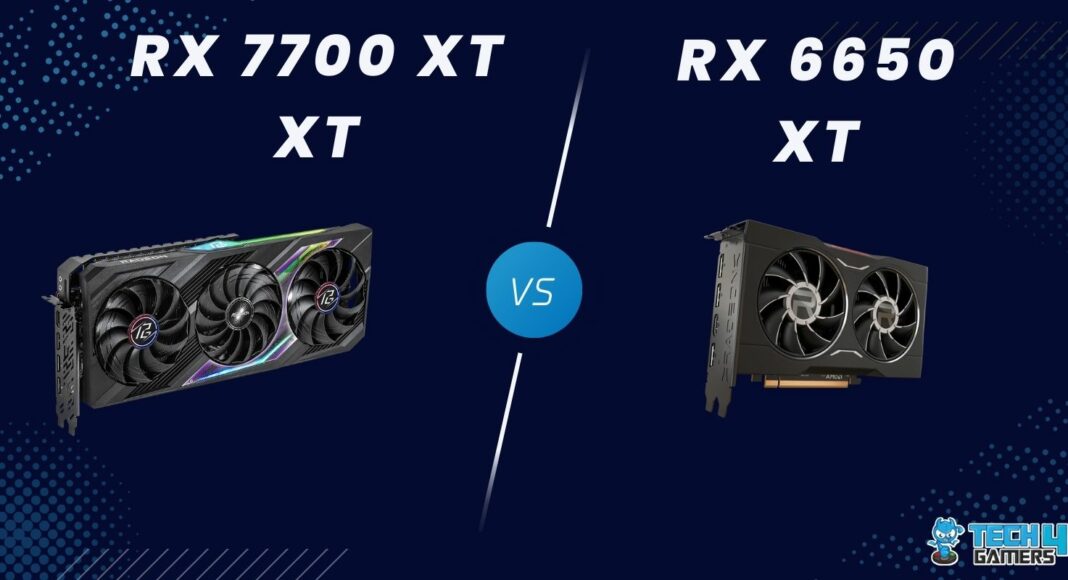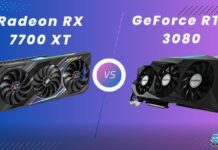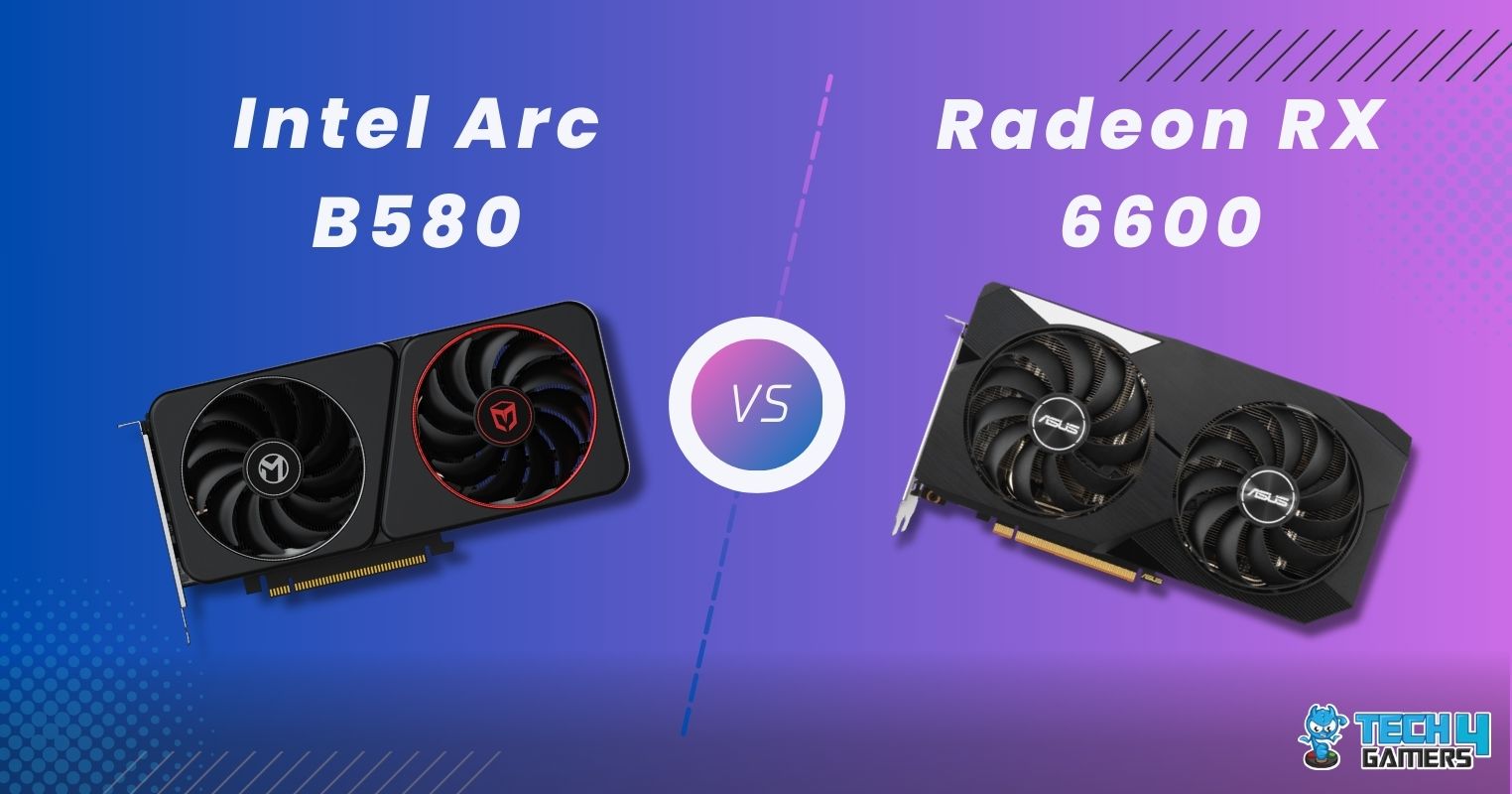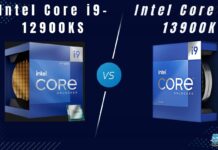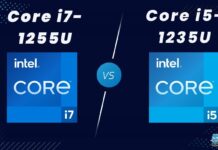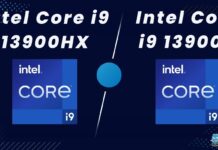AMD Radeon RX 7700 XT
Rated: 9.0/10
AMD Radeon RX 6650 XT
Rated: 8.7/10
Pros And Cons
| GPU | Pros | Cons |
|---|---|---|
| AMD Radeon RX 7700 XT | ✅ Good performance at 1440p ✅ Driver-level support for FSR | ❌ Low performance-to-price ratio ❌ Higher power draw |
| AMD Radeon RX 6650 XT | ✅ Great as an entry-level GPU ✅ Low price | ❌ Low VRAM buffer ❌ Lackluster ray tracing performance |
- In our gaming tests at 1440p, the RX 7700 XT’s performance was about 22.1% better than the RX 6650 XT.
- Talking about efficiency, the RX 6650 is about 29% more energy efficient, while the RX 7700 XT is about 7% more thermally efficient.
- In February 2024, the RX 7700 XT is priced at approximately $429, which is roughly $180 lower than the new RX 6650 XT, priced at around $249.
- I suggest the RX 7700 XT for its higher performance and newer architecture, and the RX 6650 XT for its great performance-to-price ratio and low power usage.
Comparison Table
| Technical Specs | AMD Radeon RX 6650 XT | AMD Radeon RX 7700 XT |
|---|---|---|
| GPU Chip | Navi 23 | Navi 32 |
| Architecture | RDNA 2 | RDNA 3 |
| Shading Units | 2048 | 3456 |
| RT Cores | 32 | 54 |
| ROPs | 64 | 96 |
| Memory Bandwidth | 280.3 GB/s | 430 GB/s |
| TDP | 176W | 245W |
| Best Variants | – | Best RX 7700 XT graphics cards |
Architectural Differences
- Clock Speed:The RX 6650 XT has a base clock speed of around 2055 MHz, higher than the RX 7700 XT’s 1700 MHz. Its boost clock is also higher at 2635 MHz compared to the RX 7700 XT’s 2544 MHz.
- Process Size: The 6650 XT, like all other RDNA 2 cards, is based on the 7nm processing node, whereas the RX 7700 XT uses a newer chipset design to distribute the workload of on both 5nm and 6nm processing nodes.
- VRAM: The RX 7700 XT offers a great 12GB GDDR6 VRAM compared to the RX 6650 XT’s 8GB GDDR6 memory. It also features a wider 192-bit bus, compared to the RX 6650 XT’s 128-bit bus, and boasts memory speeds around 50% faster.
- TDP: The TDP of the RX 6650 XT is much lower than the newer card at 176 watts, instead of the 245-watt TDP of the RX 6650 XT.
- Other Features: The RX 6650 XT and RX 7700 XT have similar features, with AMD updating older cards. Both have modest ray tracing and AI upscaling via AMD FSR. However, the RX 7700 XT goes further, allowing FSR activation at the driver level.
The last AMD graphics card generation featured several updates, with the xx50 XT cards standing out for their significant performance boost over the base models. This comparison will evaluate the performance of the RX 7700 XT vs RX 6650 XT to help you make the best purchasing decision.
Gaming Benchmarks
The RX 7700 XT and RX 6650 XT are two different tiers of cards from two different generations, which makes it hard to compare their performance using their specifications. To accurately measure performance, we inserted both cards into our test setup and played challenging games at 1440p resolution.
Test Bench
- OS: Windows 11
- CPU: Intel Core i7-13700K
- Motherboards: ASRock B650E PG-ITX WIFI Motherboard
- RAM: G.Skill Trident Z5 RGB 32GB DDR5-6600 CL34 Kit
- SSD: Teamgroup T-Force Z540 2TB Gen5 NVMe SSD
- CPU Cooler: Corsair Hydro Series H150i Pro RGB Liquid CPU Cooler
Assassin’s Creed Valhalla
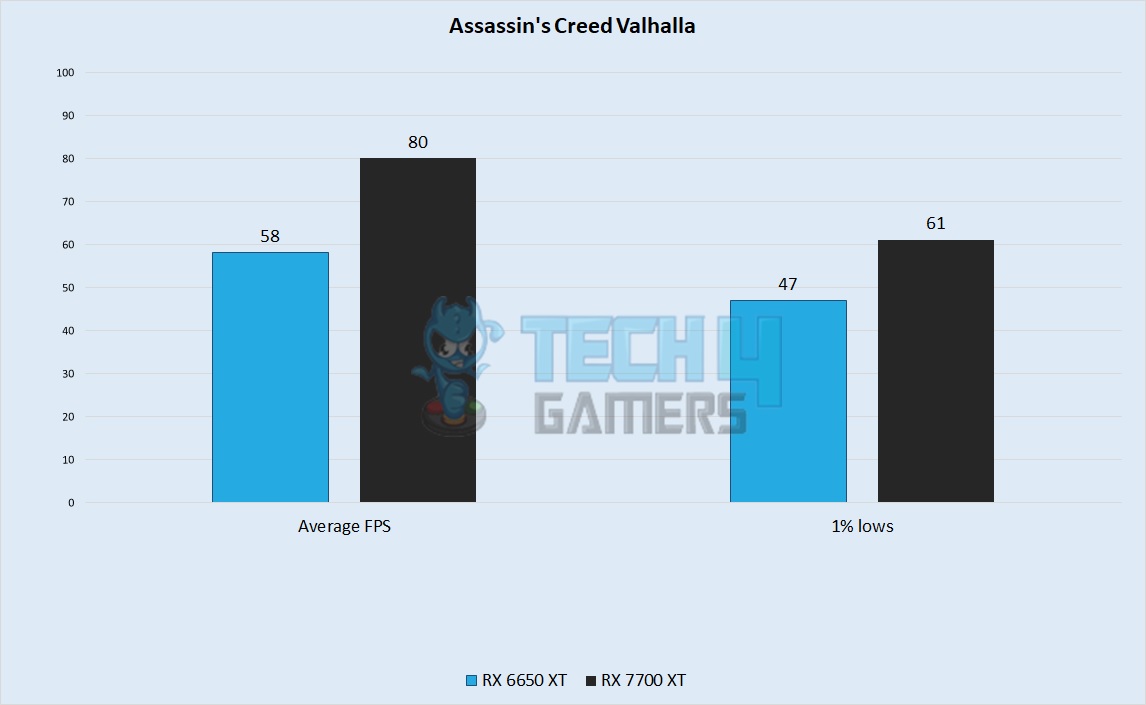
- In our first Assassin’s Creed Valhalla session, the RX 6650 XT was around 27.5% slower than its younger cousin. The newer card had an average framerate of 80 FPS, whereas the older RX 6650 XT had a generated 58 FPS on average.
- The 1% lows also suffered quite a difference between the two cards, with the RX 6650 XT going down to around 47 FPS, whereas the RX 7700 XT had a minimum framerate of 61 FPS.
Watch Dogs Legion
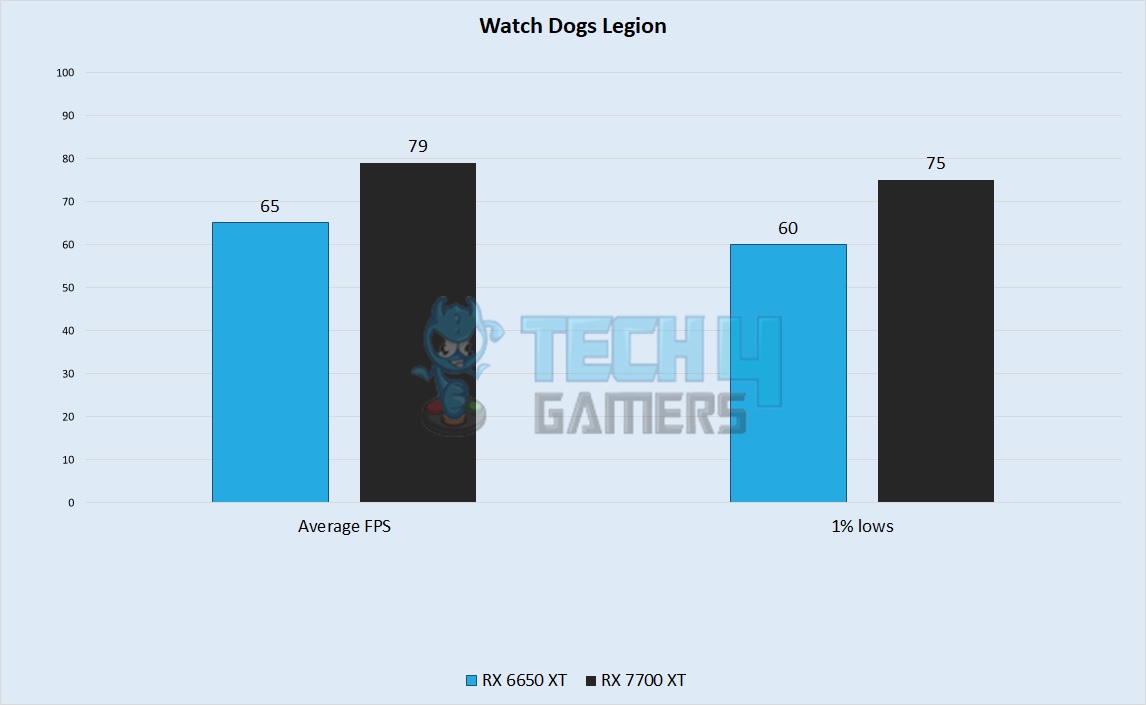
- During Watch Dogs Legion, the RX 7700 XT lead by around 18% higher performance. The RX 6650 XT had a framerate of 65 FPS, whereas the RX 7700 XT was noticeably smoother, with a framerate of 79 FPS.
- In terms of low 1% performance, the RX 6650 XT going down to around 60 FPS, whereas the RX 7700 XT kept its head well above water with a minimum framerate of 75 FPS.
Cyberpunk 2077
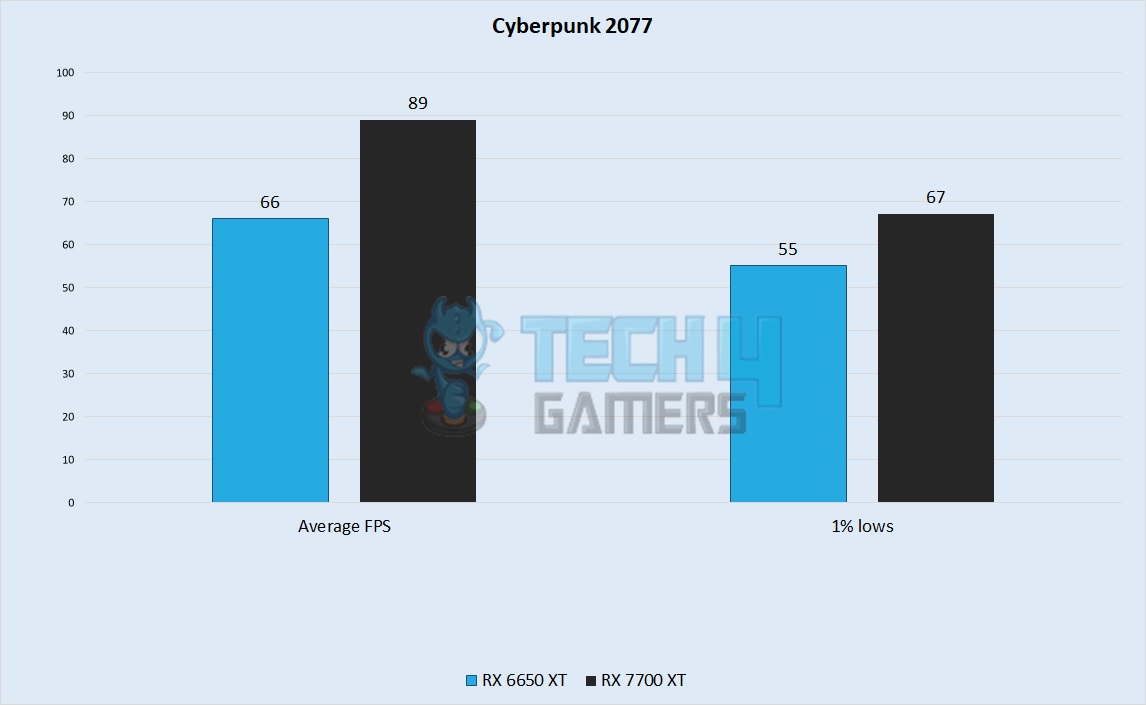
- During Cyberpunk 2077, the RX 6650 XT had an average framerate of 66 FPS, whereas the RX 7700 XT brought the average up to a silky smooth 89 FPS. This made the RX 6650 XT around 26% slower.
- Regarding worst 1% performance, the RX 6650 XT had a framerate of 55 FPS, whereas the RX 7700 XT dropped down to a framerate of 67 FPS.
Doom Eternal
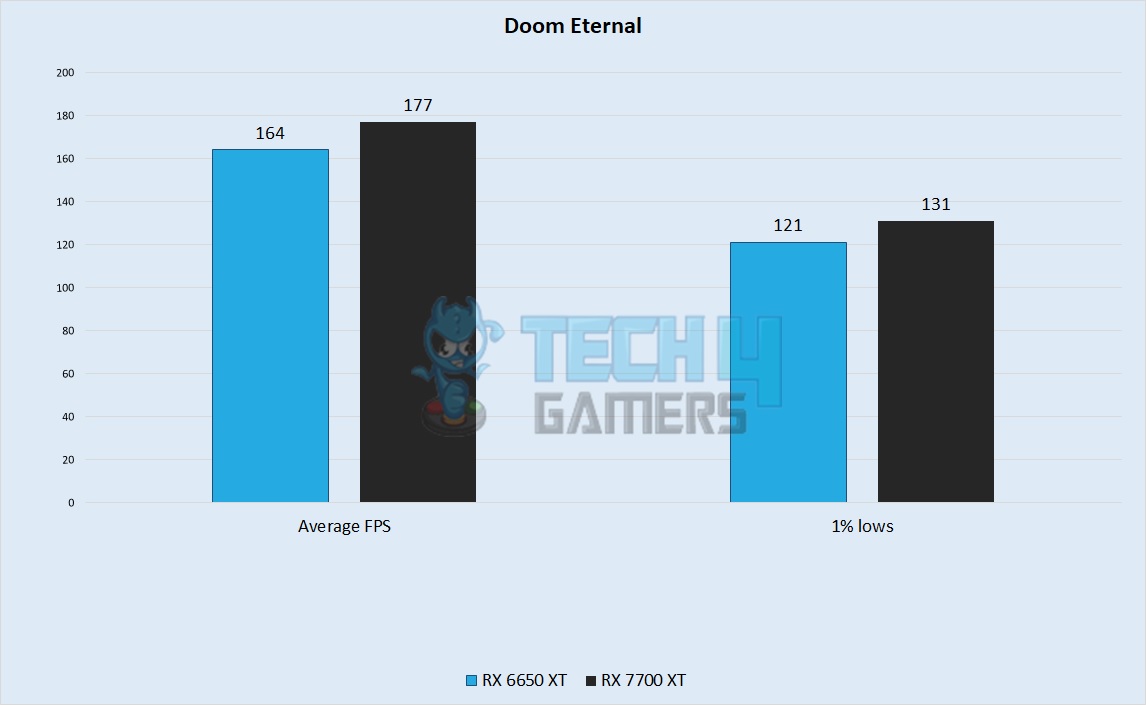
- In Doom Eternal, we saw an 8% performance difference between the two cards. The RX 6650 XT averaged 164 FPS, while the RX 7700 XT averaged 177 FPS.
- The difference in the 1% lows of this card was not drastic either, with the RX 6650 XT staying above 120 FPS with lows of 121 FPS, whereas the RX 7700 XT was even smoother with 131 FPS.
Red Dead Redemption 2
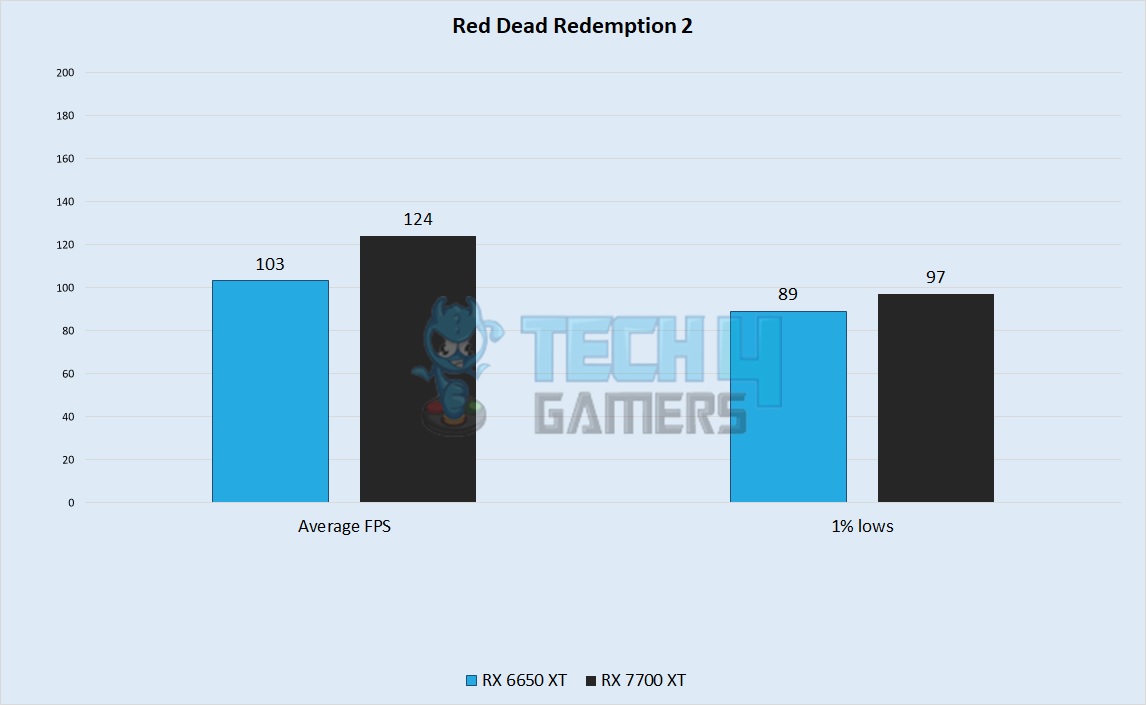
- In Red Dead Redemption 2, we notices a greater difference of 17% between the two cards, with the victor being the RX 7700 XT. It had an average framerate of 124 FPS, whereas the RX 6650 XT had an average framerate of 103 FPS.
- Coming to low 1% performance, the RX 6650 XT provided 89 FPS, while the newer card delivered a superb 97 FPS in this game.
Horizon Zero Dawn
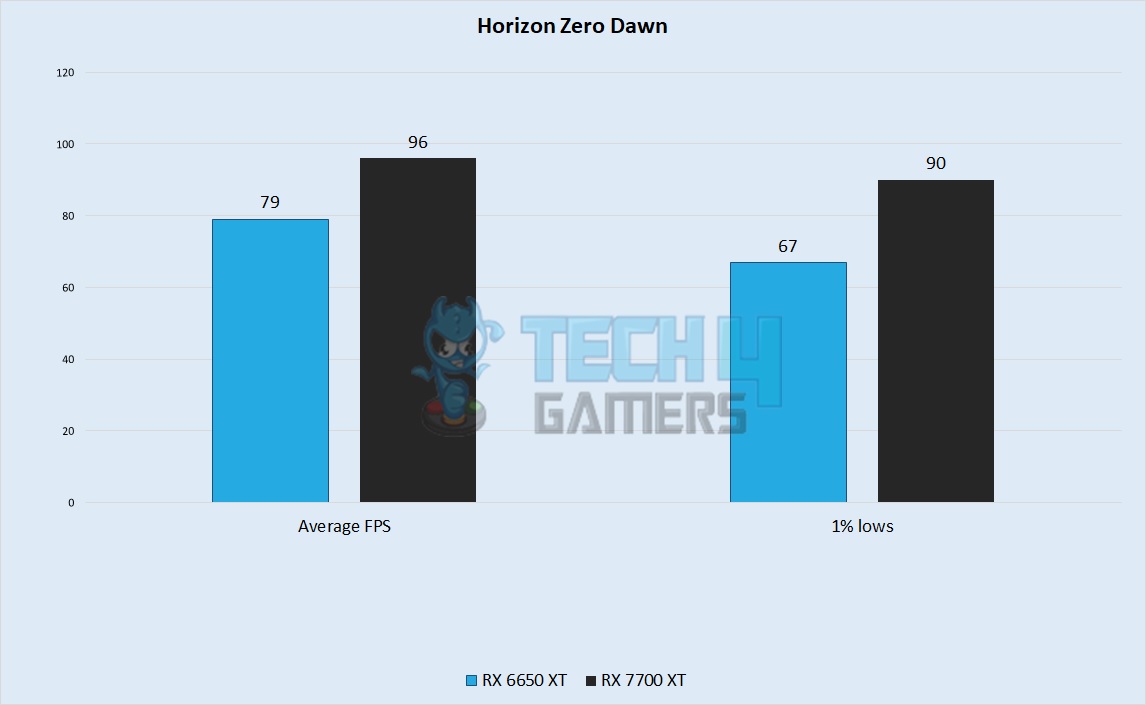
- During Horizon Zero Dawn, we experienced an 18% better performance with the RX 7700 XT. The RDNA 3-powered card had an average framerate of 96 FPS, whereas the RDNA 2 card ran at an average of 79 FPS.
- Regarding low 1% frame rates, the RX 7700 XT provided 90 FPS, whereas the RX 6650 XT maintained 67 FPS.
Assassin’s Creed Odyssey
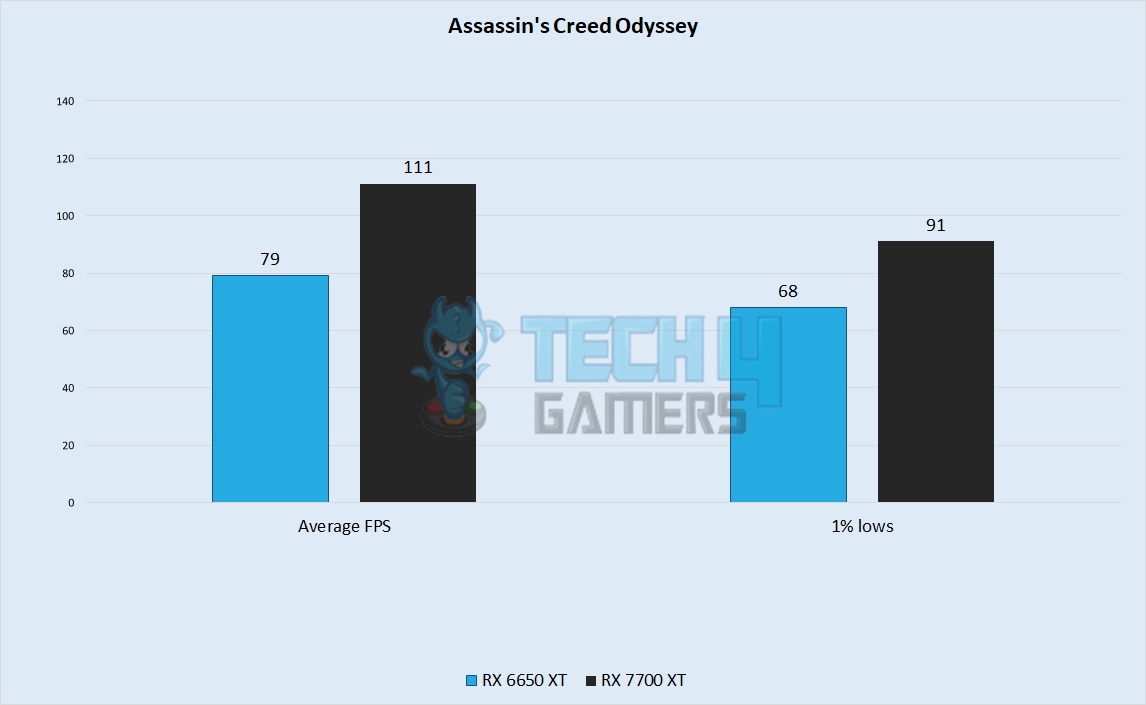
- In our last gameplay of Assassin’s Creed Odyssey, we saw a 29% performance lead with the RX 7700 XT. The RX 6650 XT generated an average of 79 FPS, while the RX 7700 XT averaged 111 FPS.
- During the worst 1% performance time, the RX 6650 XT provided a framerate of 68 FPS, whereas the RX 7700 XT had a framerate of around 91 FPS.
Overall Gaming Analysis
Performance
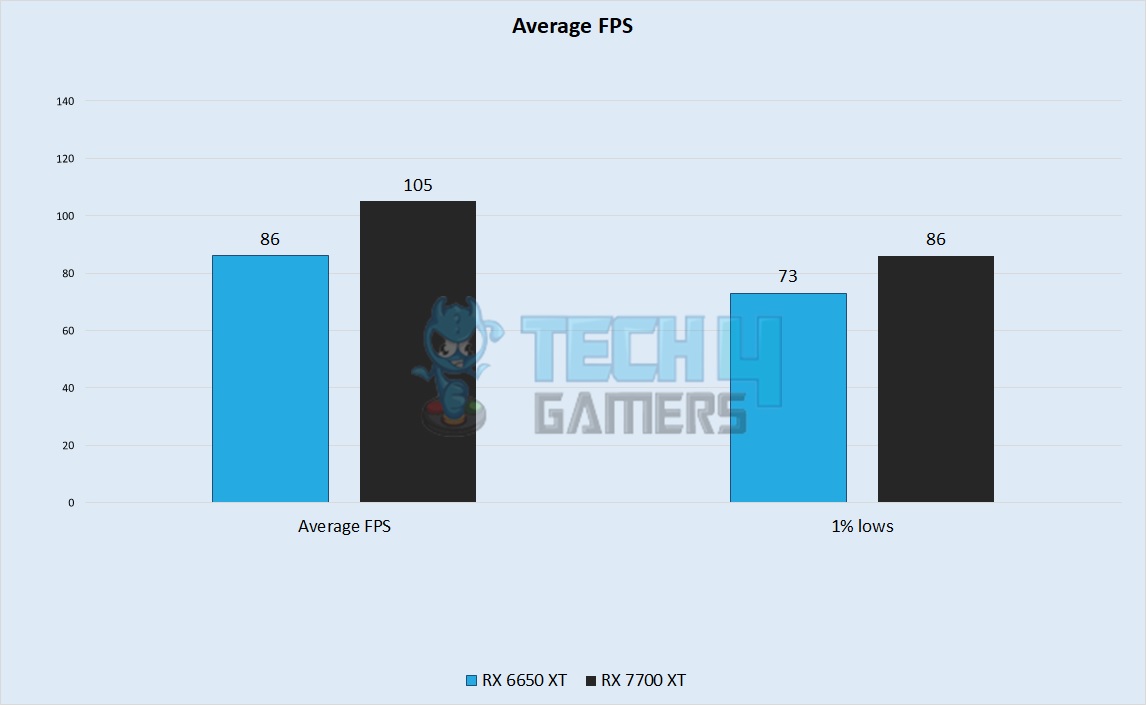
According to our test results, we found that the RX 7700 XT performs about 22.1% better than the RX 6650 XT. Specifically, the RX 7700 XT achieved an average of 105 FPS in our gaming tests at 1440p, while the RX 6650 XT averaged around 86 FPS.
In terms of worst 1% performance, the RX 7700 XT performed about 17.8% better than the RX 6650 XT in our testing session. The RX 6650 XT supplied a framerate of 73 FPS, whereas the low 1% frame rate of the RX 7700 XT on average was around 85 FPS.
Winner: AMD Radeon RX 7700 XT
Thermal Efficiency
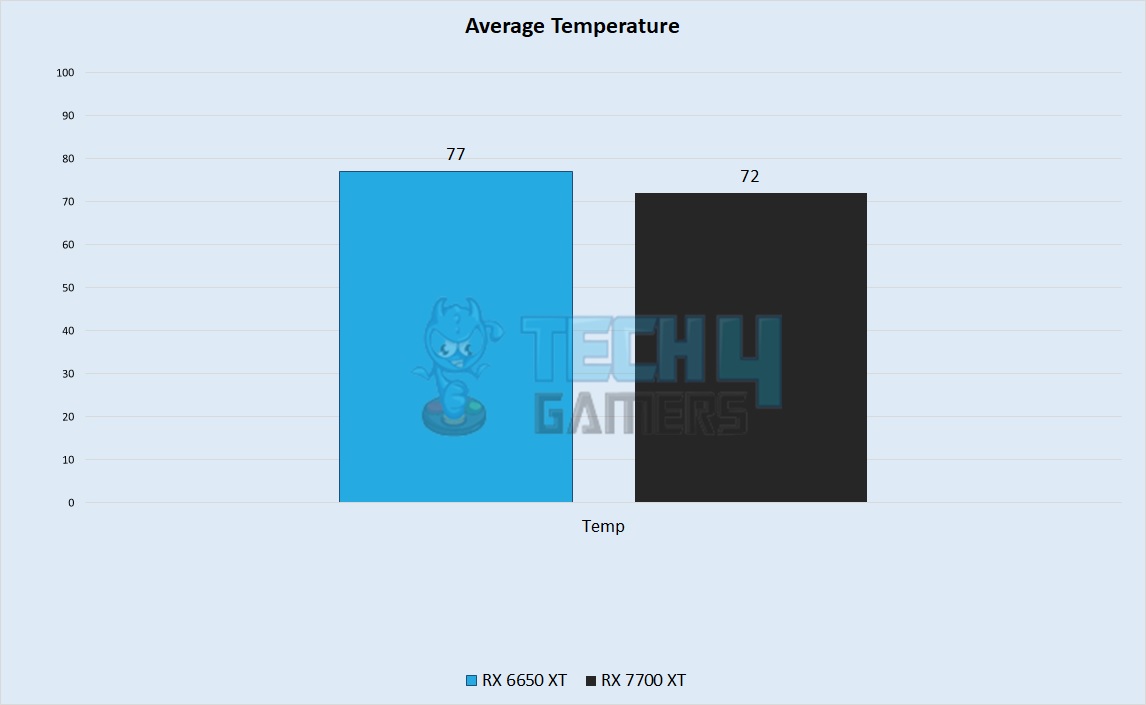
According to our testing, the temperatures were cooler on the RX 7700 XT, in which it averaged a peak of 72°C, whereas the RX 6650 XT had an average temperature of around 77°C. So, we can say that the RX 7700 XT is approximately 7.0% better at managing heat compared to the RX 6650 XT.
Winner: AMD Radeon RX 7700 XT
Power Efficiency
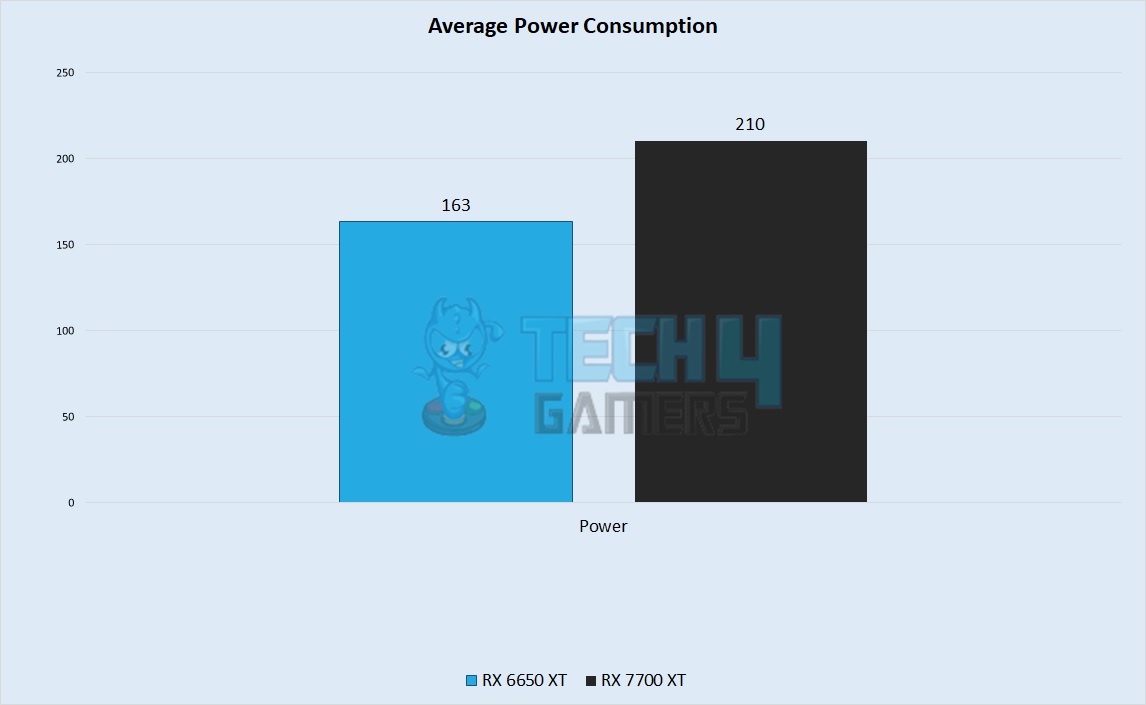
During our gaming session, the RX 7700 XT used about 210 watts on average, while the RX 6650 XT used around 29% less power, at about 163 watts. Therefore, the RX 6650 XT exhibits superior energy efficiency.
Winner: AMD Radeon RX 6650 XT
Price And Value
| GPU | Launch MSRP | Current Price |
|---|---|---|
| AMD Radeon RX 7700 XT | 💲449 | 💲429 |
| AMD Radeon RX 6650 XT | 💲399 | 💲249 |
| Price Difference | 28.6% | 72.0% |
Since the RX 6650 XT was launched, a significant time has elapsed, and a new generation has been introduced, which is why its current price is now so low. When you look at how well it performs compared to its price, the RX 6650 XT gives you more bang for your buck.
RX 6650 XT Vs RX 7700 XT: Which One Should You Go For?
AMD Radeon RX 7700 XT: The RX 7700 XT is a powerful, new GPU that can smoothly run games at 1440p resolution, delivering high frame rates. Its advanced RDNA 3.0 architecture and enhanced FSR technology further boost its performance.
AMD Radeon RX 6650 XT: The RX 6650 XT is an excellent GPU for its current price of $249. It offers significantly better performance for the money, and its lower power usage can help save on electricity costs, making it a smart choice for budget-conscious users.
Now that we’ve thoroughly discussed the RX 7700 XT vs RX 6650 XT in architectural difference, gaming performance, power consumption, thermal efficiency, and value, you can easily decide which GPU better suits your needs and fits your budget.
From the eBay listings up right now, most people are selling the card close to its new price at the moment. You can hunt a deal down for less, but it isn’t readily available. Both cards aren’t very good at ray tracing, so much so that the hit in framerate makes games unenjoyable. If you plan on using these cards for ray tracing, the RX 7700 XT’s higher base performance and its more mature RT cores help with a smoother gameplay experience. You can still play many modern games with the VRAM of the RX 6650 XT, but some titles have started listing 8GB as a minimum requirement, which is alarming.Frequently Asked Questions
More From RX 6650 XT:
More From RX 7700 XT:
Thank you! Please share your positive feedback. 🔋
How could we improve this post? Please Help us. 😔
[Hardware Reviewer]
Hi! I’m Ali Tauseef, and I have been writing for Tech4Gamers since 2022. I love all things computer hardware but am particularly fond of CPUs and motherboards, and I like to stay up-to-date about the latest advancements in these worlds, and when possible, write about it. When I’m not doing that, I like to get into a little FPS action in CS2 or get lost in the vast world of RDR2.
Get In Touch: ali@tech4gamers.com


